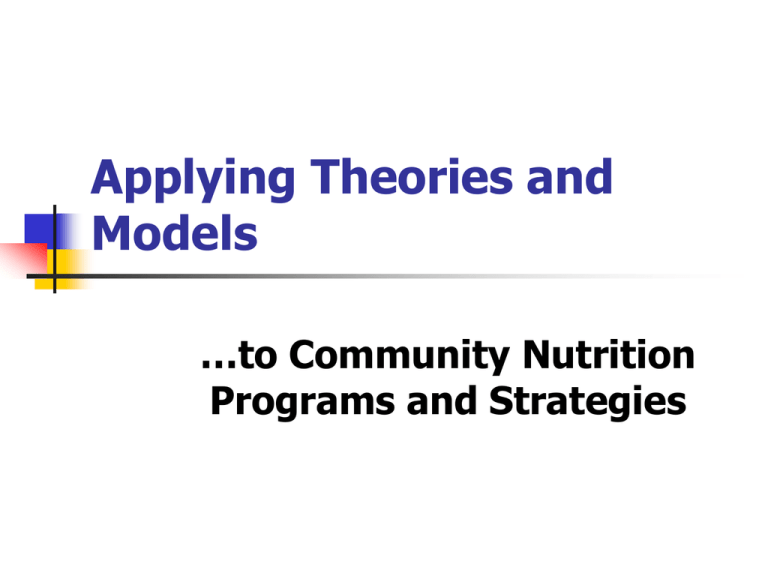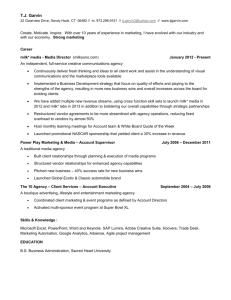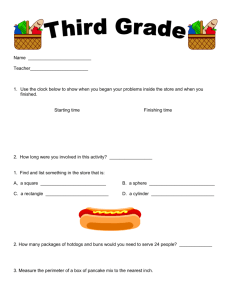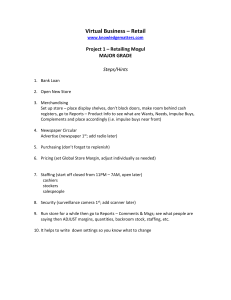20Week 4 & 5 2011 Theories and Models of Health Behaviour
advertisement

Applying Theories and Models …to Community Nutrition Programs and Strategies Theories & Models of Health Behaviour We will explore: Factors that influences our food choice behaviours Theories & models of health behaviour Community & System level change strategies (Community Development, Social Marketing, Policy) Food Choice Behaiours READ Raine, K. (2005). Determinants of healthy eating in Canada. An overview and synthesis. Can. J. Public Health, 96, suppl 3, S8-S14. Personal Food Choices Physiological factors Food Preferences Nutritional Knowledge Perceptions of Healthy Eating Psychological Factors Personal Food Choices? Environmental Factors Interpersonal influences Physical environment Economic environment Social environment Creating Supportive Environments - Policy Food Choices Food choices, eating behaviours and resulting nutrional health are influenced by a number of complex and interrelated individual, collective and policyrelated determinants. A growing body of research is supporting the relationship between food preparation and cooking skills and food choices of children and adolescents within the family context. Health Canada, Improving Cooking and Food Preparation Skills, 2011 Food Choices Diet quality of youth related to frequency of family meals AND involvement in food prep Taste, nutritional value, cost and time Main factors behind food choice & prep decisions ACROSS SES groups Low SES report cooking from ‘scratch’ more often AND use of fewer convenience foods Health Canada, 2011 Best Practices for Interventions Theoretical basis clear Experiential/hands-on learning Or minimally based on set of “defendable community-relevant assumptions” Promotes self confidence through skill development Include self-assessment of eating patterns & behaviour change tracking Health Canada, 2011 Best Practices Tailored for specific population group Based on measurable, specific goals Longer vs. shorter duration programs Provide reinforcement & motivation Health Canada, 2011 What are food skills? Knowledge Planning Creative use of leftovers, adjusting recipes Mechanical techniques Organizing menu, food prep within budget, teaching children food skills Conceptualizing food Food safety, label reading, ingredient substitution Following recipe, chopping, mixing, etc. Food Perception Using senses, when foods are cooked Rural Restaurant Customers Preferences Options most likely to order if available Broiled or baked meat WW bread Fresh fruit Steamed veg Regular salad dsg on side Options least likely to order if available Low-fat sour cream Low-fat salad dsg Low-fat milk Low-calorie dessert Request to hold high fat ingredients Income & supplement use Lower income adults less likely to consume vit/min supplements Higher education linked to greater supplement use Lower income Food insecure & poorer diet quality May need supplements most Findings suggest need for improved access to supplements for lower income Whiting, Adolphe, & Vatanparast, Oct 2009, DC Current Issues Food Choice Behaviours Knowledge behaviour Food Choice Behaviours Values Beliefs conceptions of reality & propositions about how the universe works Norms Permeate our lives; define who we are & where we stand; learned from socialization (Vanden Heede, et al., 2006) conception of what is desirable & undesirable principles, rules or standards for behavior - they are people’s conception of what should occur in a given situation Culture a guide for behaviour a mental map Theory a set of interrelated concepts, definitions, and propositions presents a systematic view of events or situations by specifying relationships among variables in order to explain or predict the events of the situations. Theory Used as a guide: WHY people are/are not following health advice WHAT you need to know before developing or organizing an intervention program HOW you shape program strategies to reach population and make an impact WHAT should be monitored, measured, and/or compared in the program evaluation Theory Helps us understand behavior Explains dynamics of behavior Explains process for change of behavior Identifies target for programs Identifies methods for accomplishing change Theories and models EXPLAIN behavior and SUGGEST ways to achieve behavior change Theory Keep in mind that more than one theory may be used to address an issue No single theory dominates community nutrition activities Theory Designing interventions for eating pattern changes can best be done with understanding of relevant theories and of dietary behaviors change and an ability to put them into practice (Glanz & Eriksen, 1993) Theories therefore: Guide program development Provide foundation for evaluation Model Vehicle for applying theories Provides plan for investigating or addressing a phenomenon Only represents processes; does not attempt to explain them Two models linking theory to practice Scientific model Theory defined to deduce hypotheses that are tested with experimental research design Requires replication by practitioners of exact process to find the ‘truth’ Humanistic model Theory define to seek to clarify social values Practitioners use theory to stimulate dialogue about “eating habits in living the kind of life that community members find most valuable.” Buchanan, 2004, JNEB, 36, 146-154. Theories and models Intrapersonal level (Individual) Interpersonal level Stages of Change (TTM) The Health Belief Model Theory of Reasoned Action Social Cognitive Theory Community and group level Diffusion of innovations Transtheoretical Model (TTM) – Intrapersonal Developed by Prochaska & Diclemente Stages of Change Model Transtheoretical Model (TTM) Focus Person’s readiness to change or attempt to change toward healthy behaviour Transtheoretical Model (TTM) Assumptions Behaviour change involves series of stages or steps Common stages across variety of health behaviours Tailor interventions to be most effective Encourages us to think about client’s readiness to change Transtheoretical Model (TTM) Precontemplation – unaware or not interested in making change Contemplation – thinking about taking action - next 6 mths Preparation – active decision to change and planning Action – trying to make change for <6mths Maintenance -has sustained change for >6mths Termination – no temptation and 100% self-efficacy TTM Self Efficacy confidence in ability to change behaviour & to withstand temptations to relapse Decisional Balance pros and cons of change how an individual perceives these Decisional Balance Pros of Change Pros of No Change Cons of Change Cons of No Change TTM Applications Intervention strategies should be matched with processes commonly used in particular stage of change cognitive processes used in pre-action stages Seeking information behavioral processes used in Prep, Action and Maintenance Seeking ways to strengthen behaviour TTM Applications TTM originated with addictive behaviours research e.g., smoking cessation Dietary change involves complex combination of removal of one set of behaviours & acquisition of new set of behaviours Measurement of definite stage of change is more difficult TTM – use to increase V/F intake in preschool children Low-income parents & primary caregivers (N=238) Incorporates staging algorithm for increasing V/F accessibility to PS children, decisional balance, selfefficacy Hildebrand, & Betts, 2009; JNEB, 41(2), 110-119 TTM – use to increase V/F intake in preschool children Precontemplation/Contemplation (43%) Preparation (29%) Best to use methods to share ideas for planning meals and snacks to include V/F Aim to build skills in making quick & economical V/F Stress parent role-modeling Encourage goal setting Action/Maintenance Hildebrand, & Betts, 2009; To prevent relapse, build social support in JNEB,in 41(2), 110-119 all learning formats TTM with low income parents & caregivers Caregivers assessed for stage of change for increasing V/F access for PS children 43% precontemplation/contemplation 29% preparation Those in action & maintenance Showed higher self efficacy u Used more behavioral processes Interventions should be tailored to stage of change Cognitive vs. behavioural Hildebrand, & Betts, 2009 Health Belief Model Intrapersonal Hochbaum, Rosenstock and Kegel 1950s to explain why people would/would not use health services Health Belief Model Intrapersonal Focus Person’s perception of a health problem & appraisal of recommended behaviour to manage or prevent the problem Health Belief Model – Three Components 1. Perception of threat to health personal threat to health concerned that ‘disease’ carries serious personal consequences 2. Outcome expectations perceived benefits and barriers to taking specific action 3. Self-efficacy belief that one can make a behaviour change Other factors affect perceived threat, outcome expectations & efficacy expectations Thus, factors influence health behaviour indirectly Using Health Belief Model Include skill-building components Be aware of times of increased threat perception increase self-efficacy ↑ likelihood of change Identify barriers to action develop strategies for helping clients overcome barriers Theory of Reasoned Action – Intrapersonal Ajzen and Fishbein Behaviour determined directly by intention to perform the behaviour Theory of Reasoned Action Intention Instructions given to self to behave in certain way Consider behaviour outcomes & opinion of significant others when forming opinions Intentions influenced by attitudes and social pressures to perform (subjective norms) Perceived social pressure to perform or not perform a behaviour Theory of Trying Intrapersonal Developed by Bagozzi Modified Theory of Reasoned Action Theory of Trying Added components that influence intention to try behaviour: past experience (success or failure) with behaviour mechanisms for coping with behaviour outcome emotional responses to process Application of Theories to Practice Self-assurance seems linked to successful behaviour change self-esteem self-efficacy Application of Theories to Practice Could screen clients upon program entry degree of readiness to change degree of past success degree of confidence in ability to change level of commitment to program Social Cognitive Theory Developed by Bandura to explain how people acquire & maintain behaviours SLT = Social Learning Theory Interpersonal Model – Social Cognitive Theory Internal/Personal Factors Environmental Factors Behavior (Bandura, 1972) Social Cognitive Theory Strength focus on target behaviours rather than attitudes & knowledge Key concepts and their implications Table 15-3, page 487 Interpersonal level applications Small Groups Social Support Supplement or substitute individual counseling Interacting with positive role models and problem solving through discussions with people with shared problems Peer Education Effective at enhancing observational learning through role models Youth and cultural minority groups Interpersonal level applications Point-of-purchase nutrition information Guide food selections in food establishments, i.e., supermarkets, cafeterias, restaurants Information during decision making increase awareness and serve as reminder Community & Group – Diffusion of Innovation Rogers and Shoemaker, 1970s to explain how product/idea becomes accepted by majority of consumers Diffusion of Innovation Focus Addresses how new ideas, products & social practices spread within a society or from one society to another Diffusion of Innovation Consists of 4 stages Knowledge Persuasion Decision Confirmation Diffusion of Innovation Spread of innovations largely by word-of-mouth Speed of diffusion is a function of number of people adopting Consumers classified by readiness to adopt new innovation innovators, early adopters, early majority, late majority, late adopters, laggards Application of Diffusion of Innovation Diffusion process facilitated by actions of different sectors Barriers to adoption occur due to disruption of habitual routines The greater the disruption, the slower the adoption Knowledge-AttitudeBehaviour Health Information Calorie per calorie, whole fruit has more dietary fibre than fruit juice. ADA position paper, Total diet approach to communicating food and nutrition information, 2007. Health Belief Model Perceived benefits, threats, barriers Whole fruits have fibre that helps me feel full. If I drink juice instead of eating whole fruit, I would get less fibre and have a harder time managing my calorie intake. That could lead to gaining excess weight which would make me feel less attractive. However, I may not be able to eat whole fruit as often as I want to because it is easier to find fruit juice when I need something that’s fast and easy from a vending machine or a convenience store. Social Learning Theory TTM, & Health Belief Model Self-efficacy I know that I can eat more fruit and less juice by learning which fruits are in season and putting those fruits on my weekly shopping list. Social Learning Theory Reciprocal Determinism If the vending machines at my office have fruit, I will be more likely to select it as a snack. TTM Stages and Processes of Change I realize that eating whole fruit is a good way to help me increase my intake of fruits & vegetables each day. I also realize that I have been getting most of my fruit in the form of juice. I will start buying more whole fruit and less juice the next time I go to the supermarket. Community-level models Frameworks for understanding how social systems function and change, and how communities and organizations can be activated Community-level models Essential for comprehensive community education individuals, groups, institutions, and communities Embody an ecological perspective Complement individually oriented behaviour change goals with broad aims that include advocacy and policy development Suggest strategies and initiatives that are planned and led by organizations and institutions, i.e., schools, worksites, health care settings, community groups, and government agencies Ecological Perspective Multiple dimensions of influence on behavior Interactions across dimensions Multiple levels of environmental influences Environments directly influence behaviors Intrapersonal factors Inter-personal processes and groups Institutional factors Community factors Public policy Community-level models Community Organization Theories Organizational Change Theory Community-level models Organizational Change theory Focus Processes and strategies for increasing the chances that healthy policies & program will be adopted & maintained in formal organizations Community-level models Community Organization Theories roots in theories of social networks and support. Emphasizes active participation & development of communities that can better evaluate and solve health and social problems Community Change: Key Concepts Empowerment process by which individuals, communities or organization obtain mastery over their lives to produce change Community Competence Community sectors able to collaborate effectively to engage in problem solving Community Change: Key Concepts Participation involvement of all community members in planning, development, & implementation of programs in the community Relevance starting where the people are; beginning with the community’s felt needs Community Change: Key Concepts Issue Selection community’s ability to identify & prioritize issues Critical Consciousness Developing understanding of the root causes of a problem Community Level Strategies Community Development Community Capacity Building Community Based vs. Community Development Community based programming is the process of health professionals and/or health agencies Defining the health problem Developing strategies to remedy the problem Involving local community members and groups to assist in problem solving Working to transfer major responsibility for ongoing program to local community members and groups Labonte, 1993 Community Based vs. Community Development Community development is the process of organizing and/or supporting community groups in their identification of important concerns and issues, and in their ability to plan and implement strategies to mitigate their concerns and resolve their issues. Labonte, 1993 Characteristics of community-based The problem name is given by the professional/institution There are defined program timelines Changes in specific behaviours or knowledge levels are the desired outcome Decision-making rests principally with the professional/institution Labonte, 1993 Characteristics of community development The naming of the problem starts with the community group Work is long term, requiring many hours A general increase in the group’s capacity is the desired outcome Power relations are constantly negotiated Labonte, 1993 Capacity Building “the strengthening of the ability of people, communities and systems to plan, develop, implement and maintain effective health and social approaches.” (PPHB Atlantic, Health Canada 2001) “an approach to the development of skills, organizational structures, resources, and commitment to improvement in health and other sectors, to prolong and multiply health gains many times over.” (Hawe, 1999) Capacity Building Individual/Personal Community Organization Systems Society Level Strategies Social Marketing Policy Change Social Marketing “ the use of marketing principles and techniques to advance a social cause, idea, or behaviour” Vanden Heede & Pelican, 1995 Social Marketing “…combines the best elements of traditional approaches to social change in an integrated planning and action framework, and utilizes advances in communications technology and marketing skills. It uses marketing techniques to generate discussion and promote information, attitudes, values and behaviors. By doing so, it helps to create a climate conducive to social and behavioral change.” (Health Canada, 2004) Social Marketing Network http://www.hc-sc.gc.ca/english/socialmarketing/ Social Marketing Aim: to influence the voluntary adoption of behavior change of the target audience Uses consumer research i.e. demographics Focus on conferring benefits & reducing barriers Primary beneficiaries are the target audience, not the marketing body The Marketing Mix The 4 P’s of marketing: Product - the “bundle of benefits” Price - “cost” of the behavior change Place – benefits must be available at the right place and the right time i.e., “the how” and “the where” Promotion – methods used to raise awareness and provide education i.e., “the what” The role of research… Market research Developing demographic, behavioral and lifestyle profiles Identifying existing behaviors, actions, needs, perceptions, attitudes and perceived benefits/barriers of the target audience Competitive analysis Identifying organizational and environmental considerations that influence behavior change Health Canada, 2004 Social Marketing CDC recommends social marketing to achieve targeted public health goals Self-guided Web course (free) Social Marketing for Nutrition and Physical Activity http://www.cdc.gov/nccdphp/dnpa/socialmar keting/training/basics Basics, problem description, Formative research, Strategy development, Intervention design, Evaluation, Implementation PLUS tips, worksheets, glossary and resources Social Marketing Examples Evidence that providing coupons for nutritious food to university students, low-income seniors, WIC participants (US) improved long term nutrition status Linking communities with local farms & encouraging pick-yourown intitiatives increased V/F intake ? Reduced obesity risk FOP Label Understanding Low-CHO claim FOP Only FOP claim seen FOP claim with Nutrition facts panel Rated low-CHO claim as more helpful to wt management AND lower in calories than same product without claim Bread with low-cho claim rated more healthful Rated products with the same nt profile the same with or without FOP claim Consumers who do not use the NF panel may misinterpret FOP claims Labiner-Wolfe, Lin, & Verrill, 2010 Online Social Marketing Projects Social Marketing: Nutrition and Physical Activity http://www.cdc.gov/nccdphp/dnpa/ socialmarketing/training/basics/ Self-guided web course in social marketing of health Modules take about 15-30 minutes to complete Tips, worksheets, resources, glossary Ecological theory and social marketing Behavior is influenced by a variety of factors. If… They believe it will reduce risk (intrapersonal) Their family requests it (interpersonal) Their employers offer a nutrition education program (organizational) There is an availability of foods that can reduce risk (community) There is improved product labeling (policy) Lefebvre, 1995 Milk - some facts… Children main consumers but by teens consumption reduced Nearly 90% teen girls and 70% teen boys don’t get the calcium they need Osteoporosis affects 1.4 million Canadians 1 in 4 women and 1 in 8 men over the age of 50 $1.3 billion in health care costs Milk viewed as high fat & associated with high fat foods Low fat milk perceived as lower in nutrients Goeree 1996, Hanley and Josse 1996, NIH Consensus statements 2000 The got milk? program History of got milk? In 1993: California Milk Processor Board (CMPB) formed Aim: to make milk more competitive & to increase consumption in California Initial target: women aged 25-44 Initial position: skim milk was healthy for adults History of got milk? 1994: milk consumption in California increased 1% 1995: the got milk? campaign was licensed to the National Dairy Board 1996: billboard ads 1998: Birth of the milk mustache 1999: gotmilk.com born History of got milk? 2000: ads promote chocolate milk 2002: California milk sales increase 1.6% since 2001 Californians used 746 million gallons of milk in 2002, the highest since 1992 2003: McDonalds McHappy Meals include milk History of got milk? By 10th anniversary: Over 95% of Americans recall campaign Spawned hundreds of got milk? rip-offs Has become a multi-million dollar licensing property Helped defend milk’s share of beverage consumption in California & the US Dairy industry spends $150 million annually to support campaign Industry worth $2 billion in California & $20 billion nationally Competition: products such as Coke and Pepsi and more recently calcium enriched beverages 4P’s of got milk? Product: e.g., milk provides vitamins and minerals to aid in the prevention of osteoporosis Price: resources needed to drink milk Place: magazines, billboards, TV actual milk: stores, schools, fast food Promotion: via ads, media campaign, web site Why television ads? To reach people in their homes Less than 5% of all milk is consumed outside the home Aim to get people to “reach for cookies and milk instead of chips and soda” Started in 1994 and in 2 years there was a 91% awareness rating Evidence its reaching the public (Evaluation) In July 2002 press release: Milk intake increased for the first time in 6 years Soft drink still number one for those 13-17 y Flavored milk big hit Per capita milk consumption among teens in 2001 was 22 gallons, 3% increase increased to 23.5 in 2002 Teens that drink milk get 34.6% of their beverage intake from soft drinks and 29.7% from milk Non-milk drinkers: soft drink-54.8% Evidence its reaching the public (Evaluation) Milk Mustache Survey 36% women said the campaign would make them drink more milk 70% who viewed the entire campaign now consider milk cool and contemporary 86% thought milk was delicious after seeing the campaign 1% and skim milk consumption has increased, while 2% and whole has decreased The campaign got over 60% awareness in just 3 months




